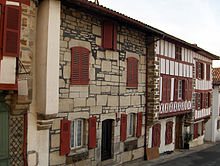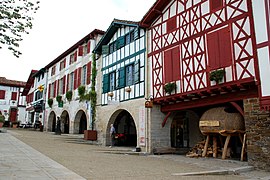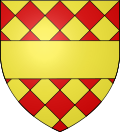|
La Bastide-Clairence
La Bastide-Clairence (French pronunciation: [la bastid klɛʁɑ̃s]; Basque: Bastida Arberoa, before 1988: Labastide-Clairence)[3] is a commune in the Pyrénées-Atlantiques department in the Nouvelle-Aquitaine region of south-western France.[4] The inhabitants of the commune are known as Bastidots or Bastidotes.[5] The village is a member of the Les Plus Beaux Villages de France ("The most beautiful villages of France") association.[6] Geography      La Bastide-Clairence is located in the former province of Lower Navarre some 20 km east by south-east of Bayonne and 5 km north-east of Hasparren. Access to the commune is by the D10 road which branches from the D936 north of the commune and comes south to the village continuing south to join the D251 just west of Ayherre. Part of the D510 forms the western border of the commune as it goes south to join the D10 near Hasparren. The D123 goes east from the village through the length of the commune to Amorots-Succos to the south-east. The D610 connects the D510 to the D10 in the commune. The commune is mostly farmland interspersed with forest.[7][8] La Joyeuse stream flows from the south through the village and continues north to become the Aran which joins the Adour at Urt. The Arbéroue stream flows from the south-east northwards through the eastern part of the commune to join the Lihoury north-east of the commune.[7][8] Places and hamletsSource:[8]
ToponymyThe commune name in Basque is Bastida or Bastida Arberoa[9] and in Gascon Occitan is La Bastida Clarença. The following table details the origins of the commune name and other names in the commune.
Sources:
Origins:
La Bastide-Clairence appears as 'LA BASTIDE Clerence on the 1750 Cassini Map[18] and as LA BASTIDE on the 1790 version.[19] History A Navarrese fortified village was founded in 1288 by Claire de Rabastens on a hillside next to the Aran river hence its Gascon name Bastida Clarença. 800 refugees, mainly from Bigorre, were granted a charter in July 1312 by Louis I of Navarre, the future Louis X of France. The birth of the village corresponds to a need for Navarre to create a strong town in the forested frontier area. La Bastide-Clairence, as its name suggests, was a fortified town. The historian Paul Broca could still see the remains of its ancient fortress in 1875. La Bastide-Clairence slowly accumulated a population of shop-keepers from south-western France then from Spanish refugees fleeing the Inquisition, and also from Basque towns and villages nearby. Another version of the origin of the town exists: it was populated by settlers from diverse backgrounds including pilgrims to Santiago de Compostela called the Francos. By 1700 the population had reached 2,000. The inhabitants lived on the nail industry, woollen garments and knitwear, and agriculture. 12-day fairs ensured the prosperity of the town. In the 16th century the locals did not speak Basque, but spoke Gascon. Subsequently they gradually adopted the Basque language and customs. The town has 320 houses and mills from the 17th century. From 1575 to 1789, La Bastide-Clairence depended on the lords of Gramont. The city had a large Jewish community after the expulsion of Portuguese Jews in the 16th and 17th centuries. Today, the Place des Arceaux and its half-timbered houses attract many art craftsmen. The houses are very typical of the region - there are two architectural types:
The commune was formerly known as Labastide-Clairence and was renamed La Bastide-Clairence on 25 June 1988. The Jewish community There was a Jewish community for about 200 years from the early 17th century to the end of the 18th century. Refugees who came from Spain and especially Portugal, the Sephardi Jews, settled in Bayonne at the end of the 16th century from where they spread to the three small towns of Peyrehorade (where they were welcomed by the Lord of Aspremont), Bidache, and La Bastide-Clairence which were protected by the Duke of Gramont. Often called "Portuguese", there were about 70-80 families in the commune in the 17th century. They lived in a relatively autonomous community designated by the expression "Jewish Nation" on the municipal records and had their own separate cemetery that was opened at the beginning of the 17th century. The inscriptions on the tombs, numbering 62, were found from 1962 to 1964 by Professor Gérard Nahon. The oldest tomb dates from 1620 with the most recent in 1785. On 18 of them, the date of death is expressed in the Hebrew calendar. From 1659 all had biblical names: Jacob, Isaac, Benjamin, Esther, Sarah, Rebecca. Among family names there are: Dacosta, Henriquez, Lopez Nunez, Depas, Alvares. The number of Jews decreased significantly in the middle of the 18th century when there were only 15 Jewish families. There remained only 6 in 1798. The cemetery belongs to the Jewish Consistory of Bayonne. Heraldry
Administration
IntercommunalityThe town participates in nine inter-communal associations:
La Bastide-Clairence is the headquarters of the sanitation association of Adour-Ursuia. DemographyIn 2017 the commune had 979 inhabitants.
EducationThe commune has one private and one public primary school.[23] EconomyEconomic activity in the commune is mainly agricultural. The commune is part of the Appellation d'origine contrôlée (AOC) zone of Ossau-iraty. Culture and heritage   Civil heritageThe old Jeu de paume (1842) Religious heritageThe commune has two religious sites that are registered as historical monuments:
Notable people linked to the commune
See alsoReferences
External links
Wikimedia Commons has media related to La Bastide-Clairence. |
||||||||||||||||||||||||||||||||||||||||||||||||||||||||||||||||||||||||||||||||||||||||||||||||||||||||||||||||||||||||||||||||||||||||||||||||||||||||||||||||||||||||||||||||||||||||||||||||||||||||||||||||||||||||||||||||||||||||||||||||||||||||||||||||||||||||||||||||







